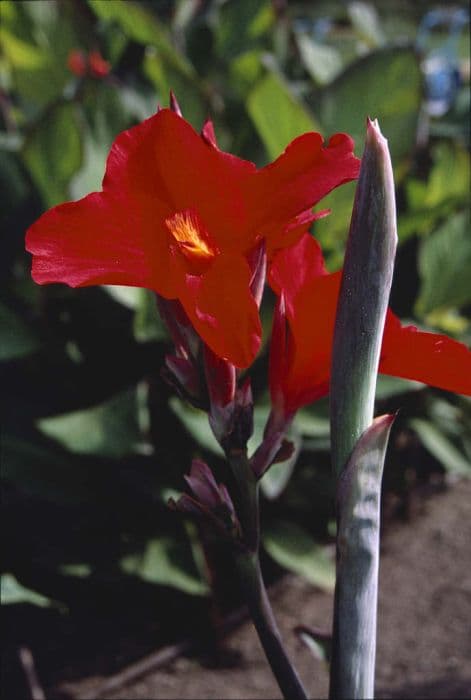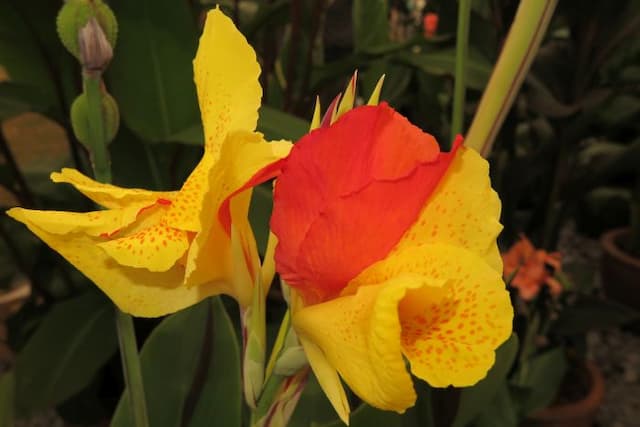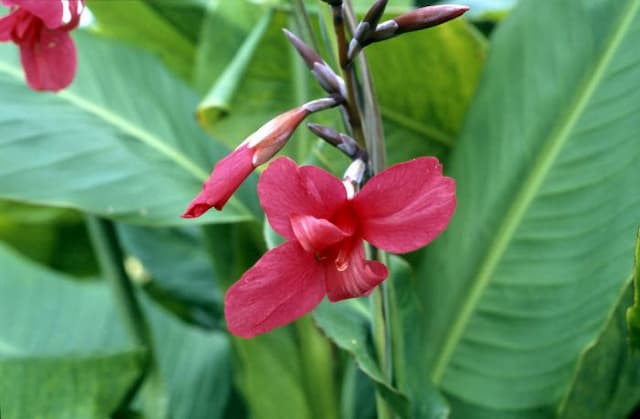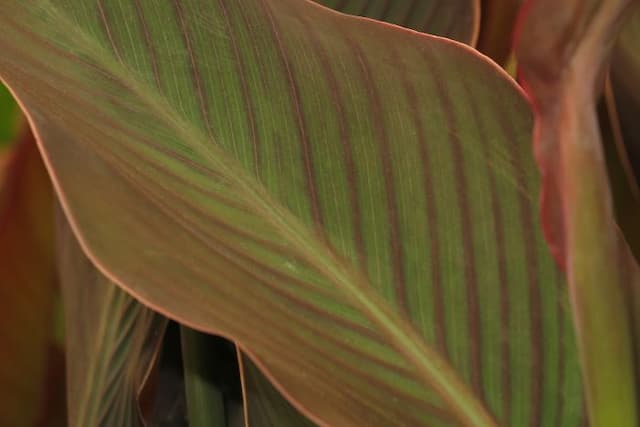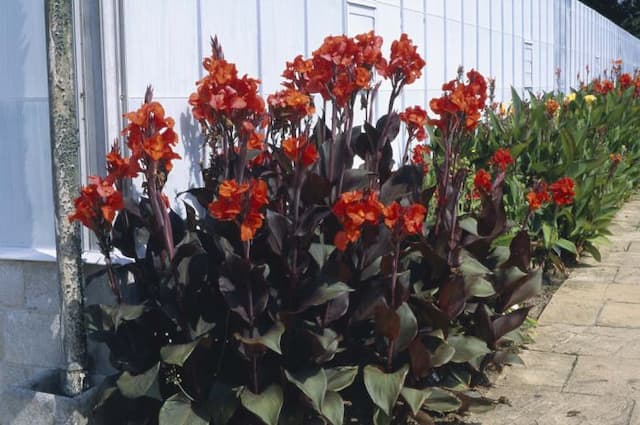Canna Lily Canna 'Ambassadour'

ABOUT
Canna 'Ambassadour' is a striking ornamental plant known for its vibrant, showy flowers and lush, tropical foliage. Its flowers are a vibrant shade of red, almost resembling flames, with each petal showcasing a satiny sheen and sometimes presenting a delicate ruffling along the edges. The blooms are bold and eye-catching, generally appearing in clusters atop tall, sturdy stalks that rise elegantly above the foliage. The leaves of the Canna 'Ambassadour' contribute to its exotic look with a deep green color, sometimes with a hint of bronzy maroon depending on light exposure. The foliage is broad and paddle-shaped, with a smooth texture, and has a prominent midrib that adds to the structural appearance of the plant. The leaves are arranged in a way that creates a lush, dense canopy, making the plant an excellent choice for adding a tropical touch to garden beds or containers. Overall, the Canna 'Ambassadour' offers a show-stopping combination of fiery blooms and striking leaves, creating a dramatic visual display that can add a touch of the tropics to any landscape design.
About this plant
 Names
NamesFamily
Cannaceae
Synonyms
Canna Lily, Canna, Indian Shot
Common names
Canna 'Ambassador'.
 Toxicity
ToxicityTo humans
Canna 'Ambassadour', commonly known as Canna Lily, is not known to be toxic to humans. There are no significant toxic effects reported from ingesting this plant.
To pets
Canna Lily is also not recognized as toxic to pets. It is generally considered to be non-toxic to dogs, cats, and other domestic animals. However, as with any plant material, ingestion of large amounts could potentially lead to gastrointestinal upset such as vomiting or diarrhea due to the fibrous nature of the plant.
 Characteristics
CharacteristicsLife cycle
Perennials
Foliage type
Deciduous
Color of leaves
Varies
Flower color
Red
Height
4 feet (1.2 meters)
Spread
2 feet (0.6 meters)
Plant type
Bulb
Hardiness zones
7
Native area
South America
Benefits
 General Benefits
General Benefits- Attracts Pollinators: Canna Lily serves as a food source for butterflies and hummingbirds, aiding in pollination.
- Easy to Grow: They are relatively easy to care for, requiring minimal maintenance which makes them ideal for both beginners and experienced gardeners.
- Long Blooming: Canna Lily typically has a long blooming period, providing vibrant color from late spring until frost.
- Dramatic Foliage: The plant's large, tropical-looking leaves add texture and a lush feel to garden spaces or containers.
- Versatility: Canna Lily can be used in a variety of garden settings, including borders, mass plantings, and as focal points.
- Moisture-loving: They thrive in moist conditions, making them suitable for waterside plantings or in areas that can be challenging for other plants.
- Improves Soil Health: Their extensive root system can help break up compacted soil, improving soil texture and health over time.
- Deer Resistant: The plant is typically not favored by deer, making it a good choice for gardens in areas where deer predation is a problem.
 Medical Properties
Medical PropertiesThis plant is not used for medical purposes.
 Air-purifying Qualities
Air-purifying QualitiesThis plant is not specifically known for air purifying qualities.
 Other Uses
Other Uses- Canna (common name) rhizomes can be processed to produce starch, known as achira, which has been used in the production of biodegradable plastics.
- In regions where Canna is native, the young shoots are sometimes consumed as a vegetable, offering an alternative food source.
- The plant's seeds are hard and dense, allowing them to be used as beads in jewelry making and musical instruments like maracas.
- Dried canna leaves can be used in crafting, such as for making natural decorative paper or eco-friendly packaging material.
- Canna's broad leaves are traditionally used as a natural wrapping material for food items, somewhat similar to banana leaves in cooking.
- The fibrous nature of the plant makes it useful for creating biodegradable ropes and rough textiles for garden use.
- The vivid color of the Canna's flowers can be used as a natural dye for fabrics, offering an eco-friendly alternative to synthetic dyes.
- In landscape design, tropical-themed Canna leaves can be used as a natural background or screen for garden vignettes.
- Canna's strong and tall stems provide physical support for less sturdy plants in mixed flower arrangements or garden beds.
- When chopped and composted, Canna's leaves and stems add valuable organic matter to garden compost, enriching soil fertility.
Interesting Facts
 Feng Shui
Feng ShuiThe Canna Lily is not used in Feng Shui practice.
 Zodiac Sign Compitability
Zodiac Sign CompitabilityThe Canna Lily is not used in astrology practice.
 Plant Symbolism
Plant Symbolism- Wealth: Canna plants have often been associated with wealth due to their large, tropical, and lush leaves suggesting an abundance of vitality and resources.
- Energy: The vivid colors of the Canna flowers represent high energy and an active spirit, reflecting the vibrancy of life itself.
- Confidence: Their bold presence in a garden setting suggests confidence, inspiring people to be assertive and self-assured.
- Pride: Cannas, with their stately and upright growth, can symbolize pride, signifying a strong sense of self and dignity.
 Water
WaterCanna lilies, including the Canna 'Ambassadour', should be watered to keep the soil consistently moist but not waterlogged. During active growth, especially in the warmer months, they may need watering once every two to three days, depending on climate conditions. It's best to water deeply, providing about two gallons per plant for each watering, which encourages the roots to grow deeper into the ground. If the top inch of soil feels dry to the touch, it's a good indication that the plant needs water. It's essential to reduce watering frequency in the cooler months when the plant goes dormant to prevent rot.
 Light
LightCanna lilies thrive best in full sunlight. For optimal growth and blooming, the Canna 'Ambassadour' should be planted in a location where it receives at least six hours of direct sunlight daily. They can tolerate some partial shade, particularly in the hottest part of the day, but too much shade can lead to leggy plants and fewer flowers. A spot sheltered from strong winds is also beneficial.
 Temperature
TemperatureCanna lilies, such as the Canna 'Ambassadour', prefer warm conditions and are best grown in temperatures ranging between 60°F and 90°F. They can survive minimum temperatures down to about 55°F, but frost can be damaging to the plant. The ideal temperature range is between 70°F and 80°F for flourishing growth. Protection from cold is necessary in areas with cool or freezing winters.
 Pruning
PruningPrune Canna 'Ambassadour' to remove spent blooms and dead foliage to encourage new growth and a tidy appearance. Deadheading, or cutting off the old flowers, should be done throughout the blooming season as needed. After the first frost in fall, cut the plants back to a few inches above the ground. This will help redirect the plant's energy to the roots for the next growing season. Pruning is typically done once at the end of the season unless maintenance is required during the growing period.
 Cleaning
CleaningAs needed
 Soil
SoilCanna Lily 'Ambassadour' thrives in a well-draining, rich soil mix composed of equal parts loam, compost, and sharp sand or perlite. The ideal soil pH for Canna Lilies is slightly acidic to neutral, ranging from 6.0 to 7.0.
 Repotting
RepottingCanna Lilies like 'Ambassadour' should be repotted every couple of years or when they outgrow their current pot. This is typically done in the spring before the growing season starts.
 Humidity & Misting
Humidity & MistingCanna Lilies, including 'Ambassadour', prefer high humidity levels but are adaptable and can tolerate lower humidity levels without significant stress.
 Suitable locations
Suitable locationsIndoor
Place in bright, indirect light with room to grow.
Outdoor
Full sun, shelter from wind, moist soil.
Hardiness zone
7-11 USDA
 Life cycle
Life cycleThe life of a Canna 'Ambassador', commonly known as Canna Lily, begins with seed germination, where the seeds need to be scarified or softened before they can sprout. Following germination, the seed develops into a young plant with a rhizome, which is a horizontal stem that typically grows underground and can give rise to roots and shoots. As it matures, the Canna Lily enters a vegetative stage, where its foliage grows more robust, displaying broad, paddle-shaped leaves. The next stage is the flowering phase, which occurs in the warmer months when spikes of bold, colorful flowers bloom and attract pollinators. After pollination, if it occurs, the flowers will produce seeds, completing the reproductive cycle. In regions with cold winters, Canna Lilies die back to the ground after flowering and enter a dormant period, during which the rhizomes survive until conditions are favorable for new growth in the following season.
 Propogation
PropogationPropogation time
Spring-Early Summer
The most popular method of propagating Canna 'Ambassador', commonly known as Canna Lily, is through division of its rhizomes. Rhizomes should be divided in the spring just before the growing season begins. One should start by carefully digging up the rhizomes and then using a sharp knife to cut them into sections, ensuring that each piece has at least one eye or growth point. The divided sections can then be replanted immediately into prepared soil, setting them about 3 to 4 inches deep and spacing them around 1 to 2 feet apart. Water the newly planted rhizomes thoroughly, which will help to establish them quickly and stimulate growth. This straightforward and efficient division method faithfully preserves the characteristics of the 'Ambassador' cultivar and quickly produces blooming plants.
